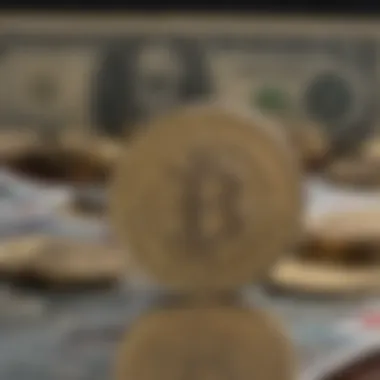Iraqi Dinar Update: Current Trends and Insights


Intro
In recent years, the Iraqi Dinar has become a topic of significant interest among investors and traders alike. This fascination doesn't come from mere speculation; rather, it is rooted in a complex interplay of historical contexts, economic factors, and shifting political landscapes. Understanding the nuances of the Dinar requires a step back, a detailed analysis of its evolution, and a look at current dynamics that are shaping its value.
As Iraq continues navigating its economic pathways amidst various challenges, the Dinar stands at a crossroad. Investors must equip themselves with insights that go beyond surface-level knowledge. Whether you are a seasoned investor or just dipping your toes into this intriguing market, grasping the current state of the Iraqi Dinar is imperative. This article endeavors to provide a thorough examination of its historical context, recent developments, and what it means for those looking to invest.
One cannot overlook the significance of international influences and government policies, which play a crucial role in the Dinar's valuation. By unpacking these elements, we aim to create a roadmap for readers, enhancing their understanding of this unique currency and its fluctuations in the wider economic landscape.
In the following sections, we will break down the intricate details that define the Iraqi Dinar while also addressing investment strategies and market trends emerging within this arena.
Prelude to the Iraqi Dinar and its Significance
The Iraqi Dinar is more than just a unit of currency; it's a reflection of Iraq's economic resilience and historical journey. Understanding its significance helps investors and traders navigate decision-making in a complex market landscape. The Dinar has undergone transformations that speak volumes about the socio-economic fabric of Iraq. Its history, intertwined with war, recovery, and ongoing challenges, positions it as a unique opportunity, albeit one that requires careful consideration.
This introduction provides the essential context to the Iraqi Dinar, laying a foundation for the deeper dives into historical trends and the currency's current role in economics. By grasping its significance, stakeholders can better anticipate shifts that influence investment and trading strategies.
Historical Overview of the Iraqi Dinar
The origins of the Iraqi Dinar, first introduced in 1932, trace back to replacing the Indian Rupee, which had dominated the region. Initially, it mirrored the value of the British Pound, signifying Iraq's economic ties at that time. However, historical events such as the oil boom in the 1970s brought prosperity but were followed by tumultuous periods, including crippling sanctions in the 1990s.
Fast forward to 2003, post the Iraqi War, the Dinar faced a monumental shift with the introduction of new currency notes, reflecting a fresh start for the embattled nation. Over the years, the Dinar’s value against major currencies has fluctuated, revealing its sensitivity to geopolitical and economic shifts. The evolution of this currency encapsulates Iraq's narrative from colonial rule to the quest for economic sovereignty.
The Role of the Iraqi Dinar in Regional Economics
The Iraqi Dinar finds its place not just in local transactions but also in regional economics. As Iraq wrestles with its identity on the economic landscape, the Dinar has had a fluctuating yet significant role. For countries surrounding Iraq, the Dinar is a point of economic interaction, especially within trade agreements and market exchanges.
Factors such as oil exports, economic sanctions, and diplomatic relations with neighboring nations continually influence the Dinar's perceived value. With Iraq being home to some of the largest oil reserves in the world, the Dinar’s strength is often tied to oil prices, creating a direct correlation between fiscal policies and external market conditions.
"The Iraqi Dinar serves as a barometer of regional stability, reflecting both the challenges and opportunities unique to the Middle Eastern economic landscape."
In summary, understanding the Iraqi Dinar is crucial for recognizing the broader economic narrative in the region. Its historical context and roles in trade, along with the influence of surrounding nations, set the stage for subsequent sections exploring the current economic environment and the market trends affecting this fascinating currency.
Current Economic Environment in Iraq
The examination of the current economic environment in Iraq is crucial for anyone interested in the Iraqi Dinar. It provides a snapshot of where the economy stands today, which plays a significant role in shaping the currency's future. Understanding this environment helps investors and traders gauge potential risks and opportunities that lie ahead.
It is worth noting that the Iraqi economy is unique, influenced heavily by its oil resources, government policies, and external economic factors. These elements can swing the economic pendulum in various directions, making it imperative to monitor them closely.
Growth Indicators and Economic Performance
Iraq's economic performance is often tied directly to its oil production. As one of the top oil-producing nations, fluctuations in oil prices, both locally and internationally, can significantly impact growth indicators. In recent years, a steady increase in global oil prices has led to enhanced revenues for the Iraqi government, enabling it to invest in infrastructure and services. These investments create jobs, stimulate local economies, and promote overall growth.
Moreover, there's an observed increase in non-oil sectors, such as construction and telecommunications, which showcase the diversification efforts by the government. However, the growth is not without challenges. The aging infrastructure, high unemployment rates, and an ongoing reliance on oil revenues hinder sustainable growth. Thus, while the economic indicators paint a picture of potential, it is essential to remain grounded in the realities facing the economy.
Some key indicators to consider include:
- GDP growth rates: Reflecting overall economic activity.
- Employment rates: Indicating job creation across various sectors.
- Foreign direct investment: Essential for long-term economic stability.
- Inflation rates: Highlighting price stability and consumer purchasing power.
Inflation Trends and Monetary Policy


Inflation plays a pivotal role in Iraq's economic landscape. Over the past years, inflation has seen fluctuations influenced by multiple facets, including government spending, subsidies on essential goods, and variations in the global market. The Central Bank of Iraq has embarked on various monetary policies aimed at controlling inflation and stabilizing the dinar. This delicate balance between stimulating growth and preventing rampant inflation is a tightrope that policymakers walk daily.
In recent times, inflation has been a growing concern, potentially eroding purchasing power for residents. Food prices and essential goods have seen significant hikes, often driven by regional instability and logistical disruptions. The government's response includes tightening monetary policy or adjusting interest rates.
"Achieving a stable inflation rate is essential for consumer confidence and overall economic health. Failing to control inflation can lead to an erosion of public trust in the currency."
Investors should pay close attention to announcements from the Central Bank regarding monetary policy adjustments. These decisions can have immediate impacts on currency value and, subsequently, investment strategies.
Ultimately, the exploration of Iraq's current economic environment reveals a complex tapestry interwoven with opportunities and challenges. The growth indicators are promising, yet the looming threats of inflation and regulatory obstacles could reshape the landscape in ways traders must carefully consider.
Recent Developments Affecting the Iraqi Dinar
The Iraqi Dinar's journey is shaped by myriad events—both local and international. Recently, several developments have loomed large over its prospects, making it critical to scrutinize them. These developments encompass government restructuring, the ebb and flow of international relations, and the delicate interplay with foreign investments. Keeping an eye on these aspects is beneficial for investors and traders alike, as they can significantly affect the Dinar's performance.
Government Restructuring and its Impact on Currency Stability
Government restructuring in Iraq is not merely a bureaucratic exercise; it’s a significant player in the currency's stability narrative. The reforms often influence fiscal policies and anchor economic confidence. With Iraq grappling with political challenges, recent governmental shifts aim to create a more cohesive and transparent framework. A government that operates effectively lays a foundation for a healthier economic environment, necessary for the Dinar to regain its footing in the global market.
Moreover, restructuring can bring about changes in monetary policy. For instance, if the government adopts stringent measures against corruption, this could lead to increased foreign investor confidence. More investors tend to strengthen demand for the Dinar, fostering a sense of stability.
In the context of recent leadership changes, as various ministries undergo remodeling, it’ll be worth watching how these transitions impact monetary direction. Small alterations in governance can resonate, like ripples on a pond, potentially affecting currency valuation on the international stage.
"A strong government often equates to a strong currency; the two are inexorably linked."
International Relations and Foreign Investments
International relations draw a fine line for the success and value of the Iraqi Dinar. Iraq's diplomatic ties significantly influence foreign investments, which are vital for economic recovery. The revitalization of trade relationships, especially with neighboring countries, offers breathtaking opportunities. Improved relations can lead to higher foreign investment influx, which can serve as a buffer against economic downturns.
For example, partnerships with Gulf countries such as the United Arab Emirates and Saudi Arabia can serve as beacons of hope for the Dinar. Increased trade and investments coming from these countries could alleviate some stress from Iraq's economy and support the Dinar's valuation in the foreign exchange market.
On the flip side, geopolitical tensions can pose risks. If disagreements emerge—whether over trade deals or territorial disputes—it can send investors running for the hills. The reaction of the forex market to such upheavals can lead to abrupt shifts in the Dinar's value.
In essence, the interwoven relationship between international relations and foreign investments holds substantial weight. They are essential considerations for those maneuvering in this complex landscape. Staying informed about current events can equip investors and traders with the necessary tools to adapt their strategies effectively, ensuring they don’t miss the boat in a rapidly changing currency market.
Market Trends and Dinar Valuation
In the realm of currency investing, understanding market trends is as crucial as having your finger on the pulse of the economic environment. The valuation of the Iraqi dinar does not exist in a vacuum; it is affected by a myriad of factors ranging from regional economic shifts to global market dynamics.
Monitoring these trends involves dissecting exchange rate movements and recognizing how they interplay with the various aspects of Iraq's economy. For investors and traders alike, grasping these nuances can significantly shape their strategies, helping them navigate the choppy waters of currency trading.
Recognizing the importance of market trends means acknowledging that currency valuation is often a reflection of broader economic health. When the dinar's value fluctuates, it can point to shifts in investor confidence, changes in oil prices, or political stability issues. Understanding these indicators can aid in predicting future movements of the dinar, allowing investors to make well-informed decisions.
Exchange Rate Dynamics in the Global Market
The dynamics of exchange rates for the Iraqi dinar against other currencies like the US dollar or euro are critical in assessing its market position. Factors such as international oil prices, foreign reserves, and geopolitical events can spur changes in the dinar's exchange rate, causing it to rise or fall. For instance, if global oil prices spike, Iraq—being a major oil producer—can benefit, potentially strengthening the dinar against other currencies.
Moreover, the appreciation or depreciation of the dinar can impact import/export balances. A stronger dinar may mean cheaper imports, but it can hurt local exporters by making their goods more expensive in international markets. Conversely, a weaker dinar could help boost local industries by making exports more competitive.
Key Information: The exchange rate fluctuations can often signal larger economic trends. Investors must monitor both local and global news, including developments in OPEC policies, to anticipate currency movements.
Comparative Analysis with Other Currencies


When comparing the Iraqi dinar with stronger currencies, it is vital to conduct a thorough analysis. The dinar’s performance against the likes of the US dollar, British pound, and the euro provides critical insights. Each currency has its own set of economic indicators, and gauging the dinar's strength against them reveals its relative value in the global market.
Factors such as inflation rates, interest rates, and political stability can sway the comparative strength of currencies. For example, while the US dollar may be more stable, the dinar's potential for growth might make it attractive to risk-seeking investors.
Some points for consideration in comparative analysis include:
- Inflation Rates: Different rates can affect purchasing power and demand for a currency.
- Interest Rates: Higher interest rates in Iraq could attract foreign capital, boosting the dinar's value.
- Economic Growth: Countries experiencing rapid economic expansion often see their currency appreciate against others.
In summation, understanding the market trends and the intricacies of dinar valuation is imperative for anyone looking to invest in the Iraqi currency. This knowledge not only positions investors to strategize effectively, but it also encourages a deeper comprehension of the Iraqi economy as a whole.
Investment Strategies for the Iraqi Dinar
Navigating the investment landscape for the Iraqi Dinar requires keen insight and strategy. With distinct opportunities and challenges, investors must consider well-thought-out approaches. Understanding the dynamics of currency valuation is crucial, especially for those interested in the Dinar. The importance of crafting effective investment strategies cannot be overstated; it can mean the difference between moderate gains and significant losses. Thus, comprehending both long-term stability and the volatility in the short-term can help in making informed decisions.
Long-Term Holding vs. Short-Term Trading
Investors often find themselves at a crossroads when deciding between long-term holding and short-term trading of the Iraqi Dinar. Each strategy offers unique advantages and risks that can impact overall success.
- Long-Term Holding: This approach is akin to planting a tree and waiting for it to bear fruit over a long period. Investors who choose this strategy believe in the Dinar's potential for future appreciation. They often analyze historical performances and economic forecasts, banking on slow but steady growth. Factors that support this method include:
- Short-Term Trading: Conversely, short-term trading resembles flipping a house—quick profits in dynamic environments. Traders here capitalize on fluctuations in the exchange rate to make profits quickly. Strategies involve:
- Economic Resilience: If Iraq's government stabilizes and implements meaningful reforms, the Dinar could gain in value.
- Global Demand: If international markets start to show increased demand for Iraqi oil and other resources, the currency's worth may rise.
- Market Timing: Monitoring news, economic indicators, or geopolitical events can provide insights into when to buy or sell.
- Technical Analysis: Many traders rely on charts and past trends to forecast future movements. However, this requires a nuanced understanding of market behavior.
Ultimately, the choice between these two strategies depends on the investor's risk tolerance and understanding of the marketplace. A balanced approach might even involve a combination of both tactics, allowing for an adaptable investment style.
Risk Management Considerations
Every investment decision comes with its share of risks. In the context of the Iraqi Dinar, risk management isn't just a catchphrase; it’s a necessity for anyone looking to minimize potential losses.
"Failing to plan is planning to fail."
This adage rings particularly true in the volatile world of currency trading.
Key strategies for managing risk include:
- Diversification: Don't put all your eggs in one basket. Keeping a mix of assets can protect against Dinar-specific downturns.
- Setting Limits: Using stop-loss orders can help in safeguarding gains and limiting losses. It’s a way to be in control even when the market takes an unexpected turn.
- Continuous Education: The economic landscape is always shifting. Staying informed about Iraq’s political environment and economic developments is essential.
Challenges Facing the Iraqi Dinar Today
The Iraqi Dinar presently finds itself grappling with a host of challenges that create an atmosphere of uncertainty for investors and traders alike. Understanding these issues is paramount for anyone looking to navigate the complex Iraqi economic landscape. The political instability and rampant corruption within the country's framework have profound implications on the currency's value and overall economic health. Acknowledging these challenges provides context for the broader narrative on the current state of the Iraqi Dinar.
Political Instability and its Economic Impact
Political turmoil has long been a thorn in Iraq’s side, presenting a roller coaster for the Dinar's steadiness. The constant shifts in power dynamics and governance often create an unpredictable environment. Citizens feel the effects of this volatility, ranging from the hesitance of foreign investment to the normal grind of daily economic operations.
One key impact of political instability is that it can lead to wild fluctuations in the exchange rate. As confidence wanes, investors are likely to flee to perceived safer havens. For example, during times when protests erupted over government policies, the value of the Dinar experienced swift downward trends, causing panic and uncertainty. The knock-on effect for businesses is immense; many may halt operations or alter their investment strategies, sensing that stability is far from sight.
To put it simply, a stable government is often seen as integral for a solid currency. When the fabric of political order is fraying, one can expect the Dinar to reflect that underlying instability. In fact, the Central Bank of Iraq has often had to step in, employing interventions aimed at stabilizing the currency during tumultuous periods. However, these measures are typically seen as short-term solutions rather than addressing the core issues.
Corruption and Regulatory Issues
Corruption further complicates the landscape for the Iraqi Dinar. The country's reputation for bureaucratic inefficiency and graft forms an additional layer of skepticism among potential investors. When companies or individuals face obstacles as a result of regulations that are either opaque or poorly enforced, confidence wanes. The result? A deterred influx of foreign capital when it is needed the most.


Moreover, the effects of corruption extend beyond just regulatory hurdles. There's a siphoning off of resources that could otherwise be invested in crucial infrastructure, health, and education sectors, all of which contribute to a thriving economy. A recent study highlighted that accountability and governance reforms could lead to significant improvements in economic growth. Yet, for the moment, these changes remain more aspirational than actual.
"Without combating corruption, Iraq's economy may struggle to realize its potential, affecting the Iraqi Dinar in the long run."
As these concerns hang over the Iraqi Dinar, both investors and local citizens find themselves navigating through murky waters. The challenges of political instability and corruption intertwine, creating a complex tapestry of economic obstacles that need addressing to pave the way for a more stable and reliable currency. Until a satisfactory resolution is reached, the future remains clouded, prompting cautious approaches from all involved stakeholders.
Future Outlook for the Iraqi Dinar
The future of the Iraqi Dinar holds significant importance for investors, traders, and anyone with a vested interest in the Middle Eastern economy. Understanding where the currency stands today and where it may head is pivotal for making informed financial decisions. A thorough analysis of key indicators, geopolitical influences, and economic reforms will frame the discussion in this section.
Predictions for Currency Valuation
Predicting the valuation of the Iraqi Dinar is a complex task, often influenced by a multitude of variables. Economic indicators such as GDP growth, inflation rates, and oil prices play crucial roles. For instance, Iraq's heavy reliance on oil exports means that fluctuations in global oil prices directly impact the Dinar's value. If oil prices were to rise significantly, it could lead to an appreciation in currency value, stimulating economic growth.
Analysts are keeping a keen eye on various forecasts. Some foresee gradual strengthening of the Dinar, assuming political stability persists and economic reforms take root. Conversely, if internal conflicts and corruption trends worsen, predictions could sway towards depreciation. The consensus here involves careful valuation analyses using historical data patterns and current market trends.
For traders, being aware of these predictions translates to actionable intelligence. Whether to hold long-term or engage in short-term trading hinges upon market sentiment and economic conditions. Therefore, a clear-eyed view of the Dinar’s predicted trajectory is vital for effective investment strategies.
Potential Economic Reforms and Their Implications
Economic reforms are often viewed through a lens of hope in Iraq, as they promise revitalization of various sectors. However, their real-world implementation is where the rubber meets the road. Policy changes aimed at diversifying the economy beyond oil and combating corruption can have profound implications on the Dinar's future.
There are several potential reforms on the table:
- Strengthening Governance: Increased transparency and accountability in government can help restore investor confidence, playing a crucial role in stabilizing the currency.
- Investment in Infrastructure: Allocating resources towards infrastructural development can boost domestic productivity, consequently affecting the valuation positively.
- Enhancing Trade Relations: Fostering better trade relations with neighboring countries and global powers would amplify demand for the Dinar, aiding its valuation.
Successful enactment of these reforms may not yield immediate results; however, the long-term horizon appears encouraging. As seen in other nations, legal certainty and economic diversification can bolster a currency's competence on the global stage.
Ultimately, the interconnection between these economic reforms and the Iraqi Dinar's value cannot be overstated. Positive change is only credible if it comes to fruition amidst the country’s broader economic landscape.
"Economic reform doesn’t happen overnight; it’s a grinding process that requires persistence and clear vision."
In summary, the future outlook for the Iraqi Dinar is fraught with potential yet frail in execution. Nonetheless, staying abreast of emerging trends and potential reforms provides a foundational understanding necessary for navigating this unique currency landscape.
End
The conclusion serves as a vital compass for understanding the intricate narrative woven throughout this article. It encapsulates not only the critical findings related to the Iraqi Dinar but also the broader implications of these insights for investors and the economic landscape of Iraq itself. Recognizing the importance of the Iraqi Dinar goes beyond mere currency appreciation; it includes grasping the underlying economic drivers, the socio-political climate, and future expectations that could affect its valuation.
Considering the key elements discussed, investors are beckoned to reflect on their strategies. With recent restructuring in the Iraqi government and ongoing international relations shifts, there is a heightened need for caution and adaptability. The unpredictable nature of currency markets, particularly in regions with political instability, challenges even the most seasoned traders.
Summary of Key Findings
Through our examination, a few fundamental themes have emerged. First and foremost, the historical context of the Iraqi Dinar is strikingly intertwined with the nation’s tumultuous journey. For instance, while inflation concerns have loomed large, signs of potential stabilization hint at possible growth opportunities. The interplay between government policy decisions and external economic pressures plays a pivotal role in shaping the currency's future.
In summary:
- Historical backdrop: The Dinar's evolution reflects Iraq's socio-economic changes.
- Current economic challenges: Political instability continues to hamper currency confidence.
- Influence of international dynamics: Foreign investments are essential for bolstering currency value, linking Iraq to a broader global economic framework.
Final Thoughts on the Iraqi Dinar's Future
Looking ahead, the future of the Iraqi Dinar remains a complex tapestry woven with uncertainty and potential. Predicting currency valuation is an exercise fraught with both risk and opportunity. However, hundreds of years of history have shown us that economies can rebound, given the right conditions.
Potential economic reforms, if effectively implemented, might hold the key to revitalizing the currency. These reforms could include stronger regulatory frameworks that combat corruption and enhance stability.
Ultimately, while navigating through this intricate landscape, investors must weigh their options carefully. It is crucial to remain abreast of periodic updates and market shifts that may signal favorable or adverse trends. The path forward for the Iraqi Dinar demands not just knowledge but vigilance on the part of stakeholders, ensuring that decisions are grounded in informed analysis rather than speculation.
"Understanding the currency is not solely about numbers; it reflects the story of a nation and its future prospects."







